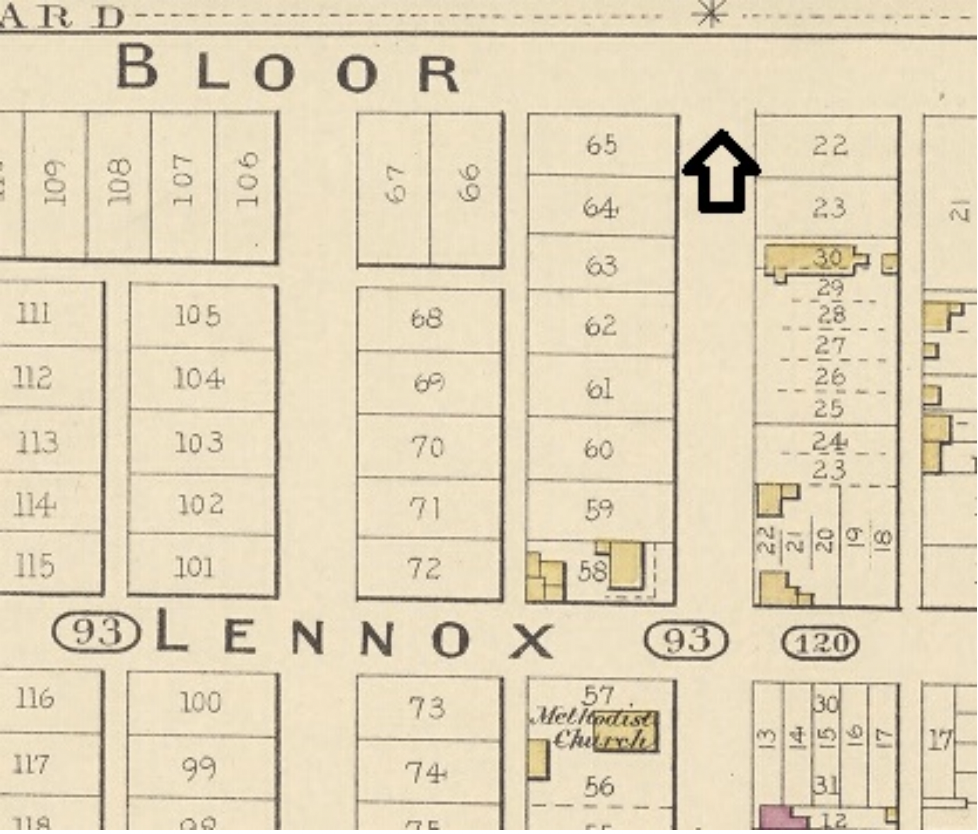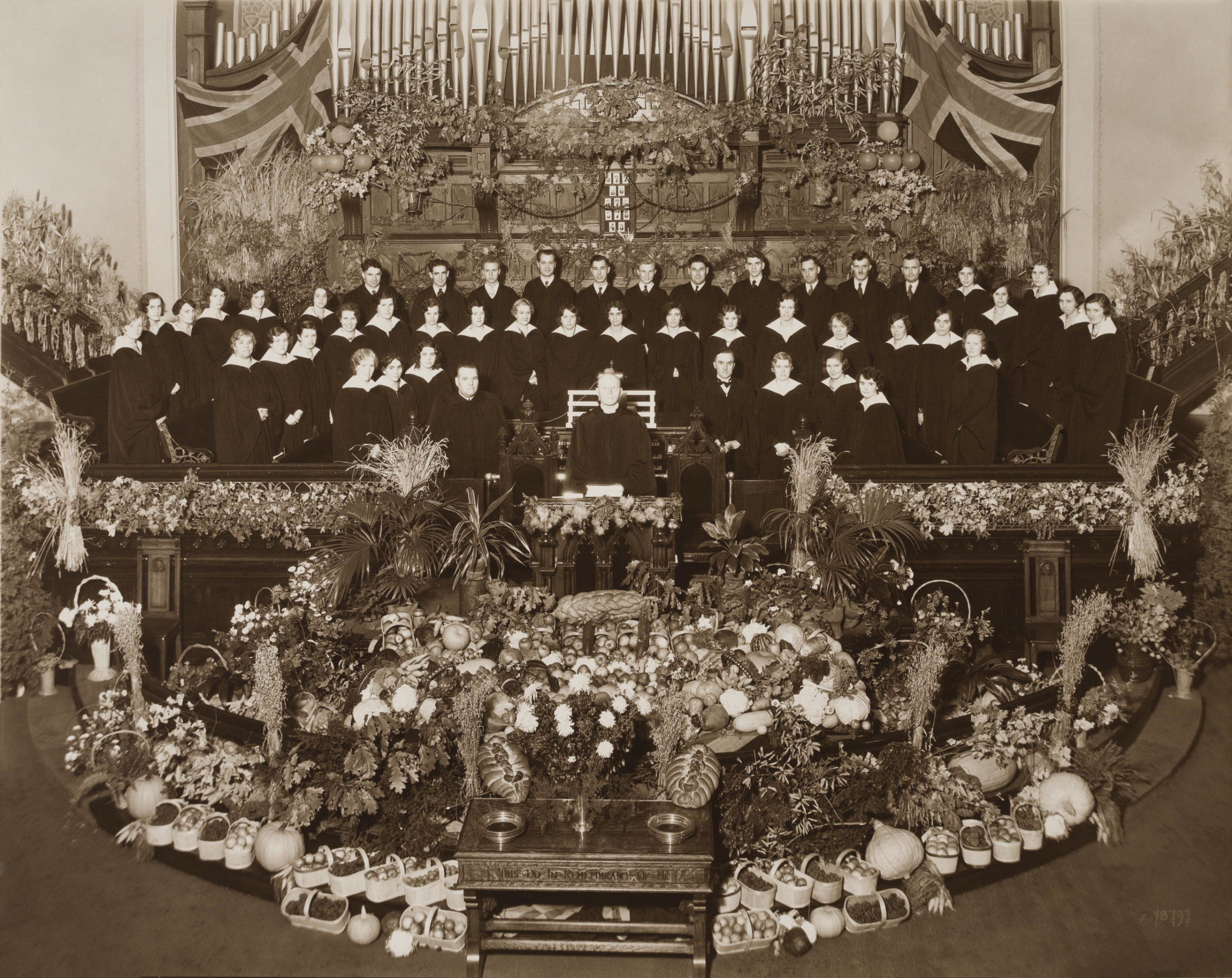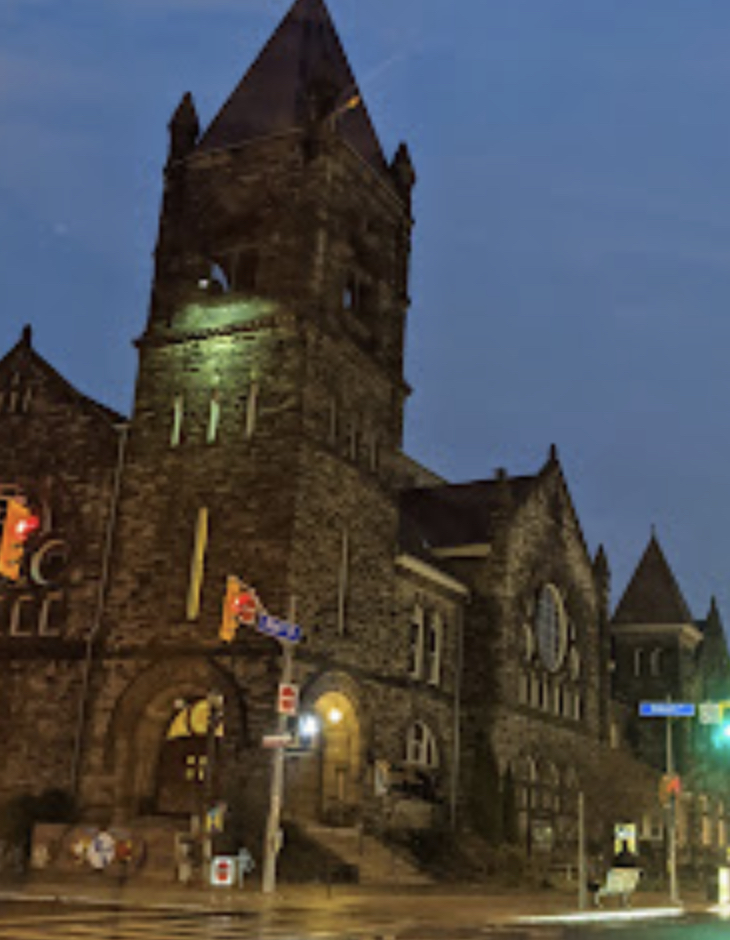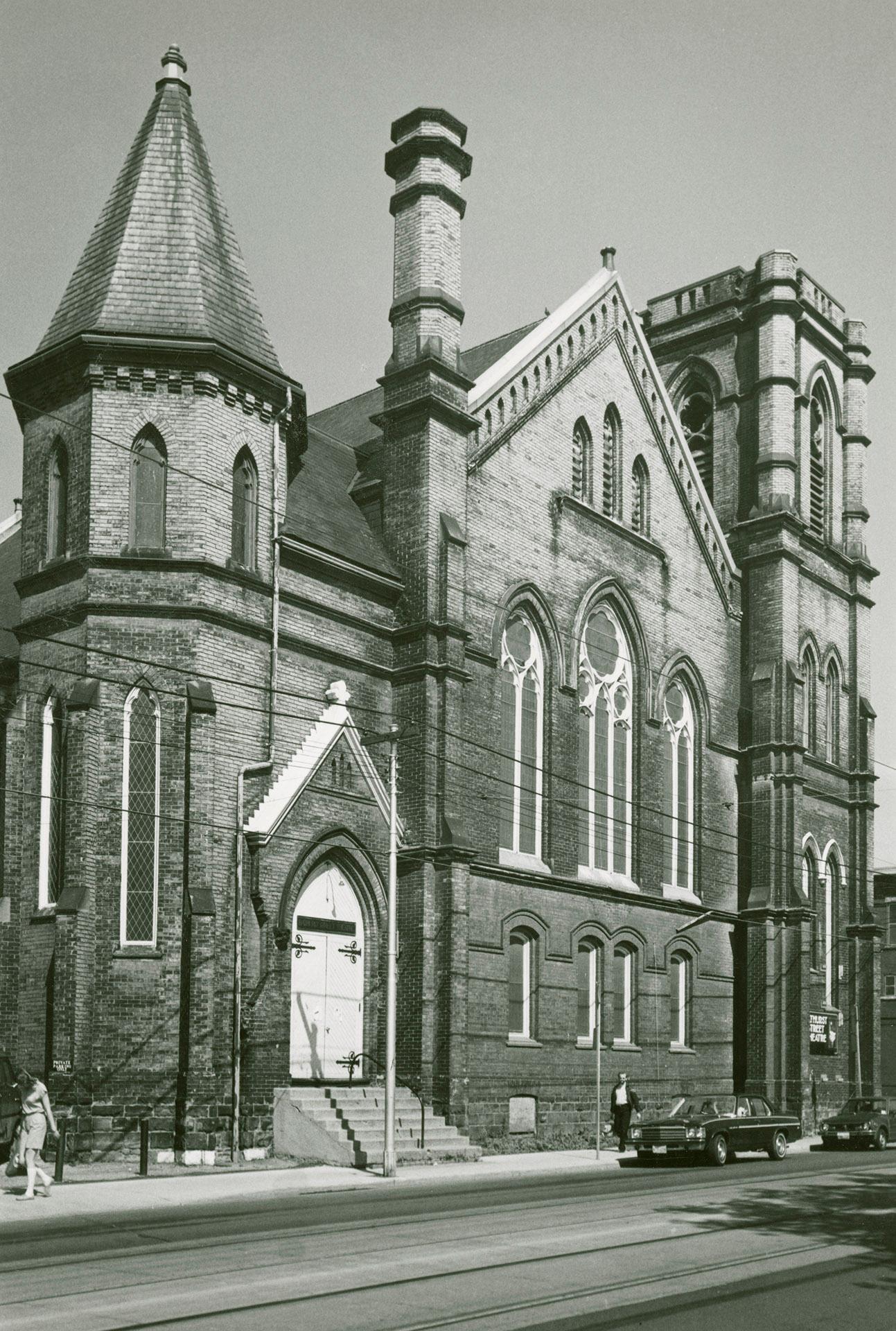Our History
Parade to Bathurst Street United Church during the Great Depression (Photo Credit: Toronto Star / Library and Archives Canada / C-029397)Timeline of our Story
1860s
Our Beginnings
In the 1860s, the district we know as Bathurst and Bloor was open fields called “commons”. In scattered cottages, people from the Wesleyan and Methodist traditions held prayer-meetings. In 1862, two small churches from those traditions organized a congregation led by the Reverend James Elliott. Four years later they built their first church, on Markham Street north of Bloor.


1880s-1920s
From Methodist to United Church
A decade later, a larger church was built on the southwest corner of Bathurst and Lennox. The present church was erected in 1888. It cost thirty thousand dollars. A Sunday school building was added in 1910.
The Bathurst congregation belonged to the Methodist Church of Canada. In 1925, the Methodists joined with Presbyterians and Congregationalists to form the United Church of Canada. And so, Bathurst Street United Church was born. In those years, Bathurst United had more than two thousand members.
1940s
Changing with the times
Bathurst-Bloor changed significantly. Many families moved to the suburbs and the area became home to an immigrant population and changing religious traditions. This meant new challenges and opportunities. Throughout this time the minister was Gordon Domm. His preparation for the ministry had included training in social services. Reverend Domm was able to bring new features to the life of the congregation and the surrounding community.
The forums were an effort to make the church more relevant by revitalizing the Sunday evening service. The service was shortened; and the sermon was replaced by debates and panel discussions on issues of interest. The audience was invited to participate. The speakers came from across Canada and the United States. They represented professions, business and industry, the labour movement, and various races and faiths. They included visiting government and church leaders.
Notable among the speakers was Tim Buck, the chair of the Canadian Communist Party. His family home was on Lennox Avenue, within two blocks of the church. Mr. Buck appeared at one of the forums after his release from prison.
The Sunday Evening Forum was sometimes filled to overflowing. But some members, unsympathetic to this type of program, withdrew from the congregation. Other people were drawn to Bathurst United because of the forums.
Church members opened the club in 1945 in partnership with the Kiwanis. Money came from the Loblaw Trust Fund. The club accepted boys from age seven to 17. By the early sixties it had 440 members. The program included sports, games, crafts, health studies, social activities and a summer camp outside the city.
The Beanery Gang was one of the most notorious youth gangs in Toronto’s history. Reverend Domm arranged for gang members to use part of the church for recreational and social activities, and to receive counseling.
Several community groups – choral, dramatic, social and recreational – also used the Bathurst facilities from time to time. For two years the Student Christian Movement (SCM) made the church the headquarters of its Summer Work Camp.


1950s
Reverend Glynn Firth
Mr. Domm’s successor was the reverend Glynn Firth. Rev. Firth was instrumental in introducing a program of urban training for ministry students. Especially challenging was the option of spending one night on the streets (or in a hostel if students were lucky enough to get in). Along with other Bathurst members, Rev. Firth also joined religious groups across Toronto in the peace movement’s protests and marches.
Rev. Firth helped organize the Bloor-Spadina Inter-church Group. “INTCH”, as it was known, sponsored many community initiatives. They included The Gathering Spot and Senior Adult Services. Two Bathurst members, Keith Roos and Mae Dawes, gave many years of leadership to those agencies.
One Bathurst program that had a significant impact on the community and the congregation was “Hi C”. Hi C started in 1957 as mid-week meetings on topics of interest to teens in the downtown area. Twenty volunteers organized games, sports, drama, weekend camps, counseling, and leadership conferences. In one season as many as 180 young people were involved. The first full time youth worker at Hi C was Bill Sanders. He had worked with young people in the inner city of New York. Bill was succeeded by Don Munro, whose family joined the congregation.
Many longstanding members of Bathurst United were part of the congregational and volunteer activities in those days: Ray and Betty Harris, Margaret Howe, Yoshi Kuwabara, Aston Clarke, and Pat and Audrey Douglas. Lawrence Goudge directed the Bathurst choir. Glynn Firth also sang in the choir.
1970s
Reverend Milton Little
In the early 1970s, the Reverend Milton Little became the minister. Milton and his wife, Vera, carried on the tradition of activist service. They held stimulating Sunday programs for the congregation’s teens. As members of “Ploughshares”, they at one time withheld a portion of their income taxes. Milton and Vera provided outstanding inspiration in the search for peace and social justice.
In the mid seventies, Milton resigned to take up a position with the Ontario Human Rights Commission. The Reverend Stuart Coles became Bathurst’s minister.
Stuart, Frances Combs, Angie Pritchard and Peter Davies co-founded Bridgehead Trading; the first Canadian company to market fair trade tropical products. The venture was such a success that the founders eventually turned over its management to Oxfam. Bathurst was also a founding member of the Bread and Roses Credit Union.
How Does Prayer Work?

1980s
Bathurst moves
Longtime member Nancy Tyrrell was a noted peace activist. She was imprisoned for her protests against Litton Industries and the cruise missile. After her death in 1986, a congregational banner was made from her clothing as a tribute. Nancy’s memorial service was the last such service in the old church building. A wide-ranging number of mourners attended, reflecting the diversity of Nancy’s work for social justice.
For many years, the congregation made strenuous efforts to meet financial demands by renting out space in the church to community and theatrical groups. Each tenant had a seat on a building management committee. However, by the mid 1980s the responsibility of keeping up a large, old building was too onerous for a small congregation.
So, the members decided to relocate. In December of 1985, two young trumpeters led the congregation in a procession along Bloor Street to Trinity-St. Paul’s. From that time on, Bathurst has held its worship services in the chapel at Trinity-St. Paul’s.
Toronto South Presbytery took over the old building, with Stuart staying on as administrator until his retirement in 1986.
Frances Combs joined Bathurst in 1980 and became a member of the staff in 1982. Frances served as lay minister for worship and pastoral care while Stuart was minister for outreach and administrator of the church building. Frances was ordained in 1987, and served as minister until her retirement in 2000.

2000s
Reverend Ralph Carl Wushke
In September of 2000, the congregation welcomed the Reverend Ralph Carl Wushke as Frances’ successor. Ralph Carl’s ministry continued the social justice traditions, and the congregation’s role as an inclusive ‘affirming’ church, open to all persons whatever their sexual orientation. Ralph Carl was ordained as a United Church minister in 2004. Frances is still a member of the congregation. She is now our Volunteer Pastoral Associate.
The Bathurst-Lennox church building was used as a community centre and theatre until it was sold in 2002. Toronto South Presbytery of the United Church of Canada created a foundation that used the proceeds from the sale to fund social ministry projects.
After Ralph Carl announced his retirement, the congregation began a discernment process to reflect on its future. Ralph Carl retired in 2018. We explored meeting at College Street United Church. After a short trial we decided to remain at Trinity St Paul’s for the moment. In March 2020, like many churches, we moved to a virtual format for our activities. We currently meet on Zoom.
1985
A social Justice Legacy for a Church Building
When the congregation relocated in 1985, Toronto South Presbytery became responsible for the property. Presbytery’s board represented several congregations in the west downtown.
The building was named the Bathurst Street Centre for Peace, Justice and the Arts. In1988, the group managing the property formed the Bathurst Street United Church Corporation under the auspices of Toronto Conference. Conference was the “supervisory court” of all incorporated ministries.
The Centre carried on the congregation’s tradition of offering affordable space for community and activist groups. The building also continued to house progressive theatre companies.
By the late 1990s, the building had become financially unviable. The rental income could not cover the maintenance and upgrades to meet contemporary standards. So, the Board obtained permission to sell. In December 2000, a school for the arts bought the building for 1.6 million dollars.
A new entity, 736 Outreach, was eventually formed to distribute the proceeds in keeping with the mission of the congregation—fostering social justice by helping disadvantaged and marginalized people.
The story of 736 Outreach is told here.


2000s
Reverend Ralph Carl Wushke
In September of 2000, the congregation welcomed the Reverend Ralph Carl Wushke as Frances’ successor. Ralph Carl’s ministry continued the social justice traditions, and the congregation’s role as an inclusive ‘affirming’ church, open to all persons whatever their sexual orientation. Ralph Carl was ordained as a United Church minister in 2004. Frances is still a member of the congregation. She is now our Volunteer Pastoral Associate.
The Bathurst-Lennox church building was used as a community centre and theatre until it was sold in 2002. Toronto South Presbytery of the United Church of Canada created a foundation that used the proceeds from the sale to fund social ministry projects.
After Ralph Carl announced his retirement, the congregation began a discernment process to reflect on its future. Ralph Carl retired in 2018. We explored meeting at College Street United Church. After a short trial we decided to remain at Trinity St Paul’s for the moment. In March 2020, like many churches, we moved to a virtual format for our activities. We currently meet on Zoom.
